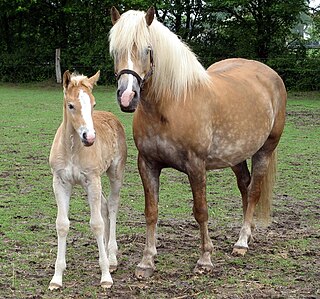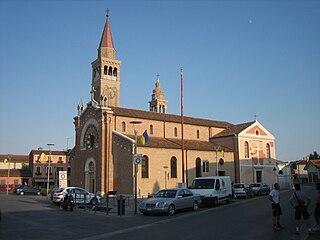
Caciocavallo is a type of stretched-curd cheese made out of sheep's or cow's milk. It is produced throughout Southern Italy, particularly in the Apennine Mountains and in the Gargano peninsula. Shaped like a teardrop, it is similar in taste to the aged Southern Italian Provolone cheese, with a hard edible rind.

The Haflinger, also known as the Avelignese, is a breed of horse developed in Austria and northern Italy during the late 19th century. Haflinger horses are relatively small, are always chestnut with flaxen mane and tail, have distinctive gaits described as energetic but smooth, and are well-muscled yet elegant. The breed traces its ancestry to the Middle Ages; several theories for its origin exist. Haflingers, developed for use in mountainous terrain, are known for their hardiness. Their current conformation and appearance are the result of infusions of bloodlines from Arabian and various European breeds into the original native Tyrolean ponies. The foundation sire, 249 Folie, was born in 1874; by 1904, the first breeders' cooperative was formed. All Haflingers can trace their lineage back to Folie through one of seven bloodlines. World Wars I and II, as well as the Great Depression, had a detrimental effect on the breed, and lower-quality animals were used at times to save the breed from extinction. During World War II, breeders focused on horses that were shorter and more draft-like, favored by the military for use as packhorses. The emphasis after the war shifted toward animals of increased refinement and height.

Lizzanello is a town and comune in the province of Lecce in the Apulia region of south-east Italy.

Cavallino-Treporti is a town and comune in the Metropolitan City of Venice, Veneto, northern Italy.

The Noriker horse, also called the Norico-Pinzgauer and historically known as the Pinzgauer horse, is a moderately heavy Austrian draught horse breed. The Noriker is considered indigenous to the central Alpine region of Europe, and is believed to have originated around the highest mountain of Austria, the Grossglockner. This region was once known as the Roman province of Noricum. At the end of the 19th century the original name Pinzgauer horse was changed to Noriker horse, due in part to the Romanophile attitude in this time.

The Livestock Conservancy, formerly known as the American Livestock Breeds Conservancy (ALBC) and prior to that, the American Minor Breeds Conservancy, is a nonprofit organization focused on preserving and promoting rare breeds, also known as "heritage breeds" of livestock. Founded in 1977, through the efforts of livestock breed enthusiasts concerned about the disappearance of many of the US's heritage livestock breeds, The Livestock Conservancy was the pioneer livestock preservation organization in the United States, and remains a leading organization in that field. It has initiated programs that have saved multiple breeds from extinction, and works closely with similar organizations in other countries, including Rare Breeds Canada. With 3,000 members, a staff of eleven and a 19-member board of directors, the organization has an operating budget of over a million dollars.

The Italian Heavy Draft, or Rapid Heavy Draft, is a breed of draft horse from Italy. The full Italian name of the breed is Cavallo Agricolo Italiano da Tiro Pesante Rapido, "Italian Rapid Heavy Draft Farm Horse", and the abbreviation TPR ) is often used.

The Neapolitan Horse, Italian: (Cavallo) Napoletano, Neapolitano or Napolitano, is a horse breed that originated in the plains between Naples and Caserta, in the Campania region of Italy, but which may have been bred throughout the Kingdom of Naples. The Neapolitan horse was frequently mentioned in literature from the 16th to the 19th centuries, and is noted for its quality. Corte wrote in 1562: "in Italy the horses of the Kingdom of Naples are greatly esteemed; [there] many fine coursers are born ... suitable for use in war and in the manège and for every service that the rider may require". The decline of the breed was noted in the early 20th century by Mascheroni (1903) and Fogliata (1908). Some sources state that by 1950, the original Neapolitan horse was deemed extinct, but its lines were incorporated into other breeds, most notably the Lipizzaner. An attempt to recreate this breed resulted in the modern breed called Napolitano.
The Ventasso Horse is a rare breed of horse originating from the upper Val d'Enza valley in the Emilia Romagna region of Italy. It is one of the fifteen indigenous horse "breeds of limited distribution" recognised by the AIA, the Italian breeders' association. It takes its name from the Monte Ventasso, in the province of Reggio Emilia.

Jesolo is a seaside resort town and comune of 26,447 inhabitants in the Metropolitan City of Venice, Italy. With around six million visitors per year, Jesolo is one of the largest beach resorts in the country, and ranks 7th overall as a tourist destination, and fourth most popular Italian seaside resort. With 204,711.4 visits per thousand inhabitants, it is also one of the 50 Italian towns with the greatest tourist pressure. Its 15 kilometres of beaches and proximity to central Europe make it a favourite destination of many Russian, German, Austrian, Dutch and French visitors.

The Giara horse is a horse breed native to the island of Sardinia. It is one of the fifteen indigenous horse "breeds of limited distribution" recognised by the AIA, the Italian breeders' association. While of small size due to the hostile environment in which it lives, and sometimes called a "pony," it is considered a true horse.

The Tolfetano or Cavallo Tolfetano is a breed of horse from the northern part of the Lazio region of Italy. It is indigenous to the Monti della Tolfa range of hills which lie within the Maremma Laziale, and which give the breed its name. The harsh terrain and limited resources of the area are thought to have contributed to the resistant and frugal nature of the breed.

The Persano is a horse breed created during the Kingdom of Naples at the Royal Stud of Persano near Serre in the Italian province of Salerno. It is similar in appearance to an Anglo Arabian and was created by crossing Andalusians, Arabians, Turkomans and Mecklenburgers.

The Cavallo Romano della Maremma Laziale, or "Roman horse of the part of the Maremma that is in Lazio", is a horse breed native to the Lazio region of Italy. An ancient breed, it was officially recognised only in 2010; it is now one of the fifteen indigenous horse "breeds of limited distribution" listed by the AIA, the Italian breeders' association. The Lazio region has assigned it the conservation status "at risk of erosion". The population numbers about 800, of which most are in the comune of Monte Romano in the province of Viterbo; a herd of approximately 200 is at Ponzano Romano in the province of Rome, and others are in the province of Rieti.

The Esperia Pony is a breed of pony originating in the area of the Aurunci Mountains and Ausoni Mountains near Esperia in the province of Frosinone, in the Lazio region of Italy. It is one of the fifteen indigenous horse "breeds of limited distribution" recognised by the AIA, the Italian breeders' association. It is the only Italian breed to be officially denominated a pony.
The Catria Horse is a breed of horse originating in the mountainous area of the massif of Monte Catria in the Marche region of Italy, and surrounding areas in the provinces of Ancona, Perugia and Pesaro. It is one of the fifteen indigenous horse "breeds of limited distribution" recognised by the AIA, the Italian breeders' association.
The Pentro or Cavallo Pentro is an endangered Italian breed of small rustic horse. It originates in the upper valley of the Volturno in the southern Italian region of Molise, close to its borders with Abruzzo, Campania and Lazio, and takes its name from the ancient Samnite tribe of the Pentri, who lived in that area. The population is concentrated in the comune of Montenero Val Cocchiara in the province of Isernia. It is one of the fifteen indigenous horse "breeds of limited distribution" recognised by the AIA, the Italian breeders' association.
The Sarcidano, Italian: Cavallo del Sarcidano, is a rare Italian breed of semi-feral horse originating from the Altopiano del Sarcidano in the comune of Laconi, in Oristano Province of the Mediterranean island of Sardinia. It is one of the fifteen indigenous horse "breeds of limited distribution" recognised by the AIA, the Italian breeders' association.
The Samolaco is a rare breed of horse originating from the Valchiavenna and Valtellina, in Lombardy, northern Italy. It takes its name from the town of Samolaco, near Chiavenna in the province of Sondrio. Gravely endangered, it is not among the fifteen indigenous horse "breeds of limited distribution" recognised by the AIA, the Italian breeders' association. The population is listed in DAD-IS as over 12 in 1994, and under 100 in 1998; one further example of the breed may have been identified during a television broadcast.

The Giara di Gesturi, Sardinian: Sa Jara Manna, is a high, steep-sided basaltic plateau which extends for about 42 km2 (16 sq mi) in the districts (comuni) of Gesturi, Tuili and Setzu in the province of Medio Campidano, and Genoni in the province of Oristano, in the southern central part of the island of Sardinia, Italy.
















